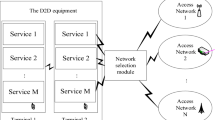Abstract
For the next generation wireless networks, machine type communication (MTC) is gaining an enormous interest as a new communication paradigm. MTC is expected to become a cost-effective solution for improving the wireless communication performance. In MTC, one of the most critical issues is to support data transfers among devices without human interaction. In this study, we introduce a new MTC control scheme for the future network infrastructure. To effectively support a large number of MTC devices, we investigate a dual-level interaction mechanism by employing the timed strategy game model. In dynamic wireless network environments, our timed strategic game approach can practically adapt current system conditions while maximizing system performance. Main contribution of this research is to show a way of MTC system modeling based on the competitive and cooperative manner. Finally, numerical simulations illustrate the validity of our game-based approach. Our solution enables a better network resource utilization for heterogeneous traffic services in contrast to existing schemes.




Similar content being viewed by others
References
Niyato, D., Wang, P., & Kim, D. (2014). Performance modeling and analysis of heterogeneous machine type communications. IEEE Transactions on Wireless Communications, 13(5), 2836–2849.
Kouzayha, N., Taher, N. C., & Ghamri-Doudane, Y. (2013). Towards a better support of machine type communication in LTE-networks: Analysis of random access mechanisms. In IEEE ICABME’2013 (pp. 57–60).
de Sousa Chaves, F., Abbas-Turki, M., Abou-Kandil, H., & Romano, J. M. T. (2013). Transmission power control for opportunistic QoS provision in wireless networks. IEEE Transactions on Control Systems Technology, 21(2), 315–331.
Chen, K.-C. (2012). Machine-to-machine communications for healthcare. JCSE, 6(2), 119–126.
Kim, B.-G., & Kang, S.-J. (2008). IEEE 802.15.4 MAC-based location-ID exchange protocol for realizing micro-cell connectionless location-awareness services. JCSE, 2(4), 412–427.
Kim, S. (2014). Game theory applications in network design. Philadelphia: IGI Global.
Xu, X., Saad, W., Zhang, X., Xiao, L., & Zhou, S. (2016). Deployment of 5G networking infrastructure with machine type communication considerations. In IEEE ICC’2016 (pp. 1–6).
Awuor, F. M., & Wang, C.-Y. (2016). Massive machine type communication in cellular system: A distributed queue approach. In IEEE ICC’2016 (pp. 1–7).
Dowhuszko, A. A., Corral-Briones, G., Hämäläinen, J., & Wichman, R. (2016). Performance of quantized random beamforming in delay-tolerant machine-type communication. IEEE Transactions on Wireless Communications, 15(8), 5664–5680.
Ijaz, A., Zhang, L., ul Quddus, A., & Tafazolli, R. (2016). HARQ in relay-assisted transmission for machine type communications. IEEE Wireless Communications Letters, 5(2), 172–175.
Li, A., Hailes, P., Maunder, R. G., Al-Hashimi, B. M., & Hanzo, L. (2016). 1.5 Gbit/s FPGA implementation of a fully-parallel turbo decoder designed for mission-critical machine-type communication applications. IEEE Access, 4, 5452–5473.
Arouk, O., Ksentini, A., & Taleb, T. (2015). Performance analysis of RACH procedure with beta traffic-activated machine-type-communication. In IEEE GLOBECOM’2015 (pp. 1–6).
Condoluci, M., Militano, L., Orsino, A., Alonso-Zarate, J., & Araniti, G. (2015). LTE-direct vs. WiFi-direct for machine-type communications over LTE-A systems. In IEEE PIMRC’2015 (pp. 2298–2302).
TalebiFard, P., Preda, S., Truchan, C., Krishnan, S., Monette, D., & Leung, V. C. M. (2016). Simplified wireless connectivity for 5G machine type communication. In IEEE INFOCOM’2016 (pp. 21–26).
Bagaa, M., Ksentini, A., Taleb, T., Jantti, R., Chelli, A., & Balasingham, I. (2016). An efficient D2D-based strategies for machine type communications in 5G mobile systems. In IEEE WCNC’2016 (pp. 1–6).
Tefek, U., & Lim, T. J. (2016). Clustering and radio resource partitioning for machine-type communications in cellular networks. In IEEE WCNC’2016 (pp. 1–6).
Jang, I., Pyeon, D., Kim, S., & Yoon, H. (2013). A survey on communication protocols for wireless sensor networks. JCSE, 7(4), 231–241.
Khaliq-ur-Rahman Raazi, S. M., & Lee, S. (2010). A survey on key management strategies for different applications of wireless sensor networks. JCSE, 4(1), 23–51.
Kim, D., Park, T., Kim, S., Kim, H., & Choi, S. (2016). Load balancing in two-tier cellular networks with open and hybrid access femtocells. IEEE/ACM Transactions on Networking (to appear).
Kao, H.-W., Ju, Y.-H., & Tsai, M.-H. (2015). Two-stage radio access for group-based machine type communication in LTE-A. In IEEE ICC’2015 (pp. 3825–3830).
Barakat, B., & Arshad, K. (2015). Energy efficient scheduling in LTE-advanced for machine type communication. In IEEE IEMCON (pp. 1–5).
Zhang, G., Li, A., Yang, K., Zhao, L., & Cheng, D. (2016). Optimal power control for delay-constraint machine type communications over cellular uplinks. IEEE Communications Letters, 20(6), 1168–1171. doi:10.1109/LCOMM.2016.2535145.
Yang, C., Li, J., & Li, W. (2009). Joint rate and power control based on game theory in cognitive radio networks. In Fourth international conference on communications and networking (pp. 1–5).
Sarcia, S. A. (2013). Timed strategic games: A new game theory for managing strategic plans in the time dimension. In IEEE CogSIMA’2013 (pp. 187–194).
Acknowledgements
This research was supported by the MSIP (Ministry of Science, ICT and Future Planning), Korea, under the ITRC (Information Technology Research Center) support program (IITP-2016-H8501-16-1018) supervised by the IITP (Institute for Information & communications Technology Promotion) and was supported by Basic Science Research Program through the National Research Foundation of Korea (NRF) funded by the Ministry of Education (NRF-2015R1D1A1A01060835).
Author information
Authors and Affiliations
Corresponding author
Rights and permissions
About this article
Cite this article
Kim, S. Timed strategic machine type communications for dual-level future wireless networks. Wireless Netw 23, 641–650 (2017). https://doi.org/10.1007/s11276-016-1398-5
Published:
Issue Date:
DOI: https://doi.org/10.1007/s11276-016-1398-5




